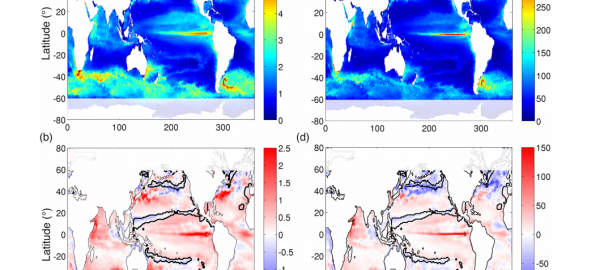Helen Hill | Darwin Project
It’s been a decade since the inception of the MIT Darwin Project, an alliance between physical oceanographers, biogeochemists and marine microbiologists at the Massachusetts Institute of Technology (MIT). The goal of Darwin remains to couple state of the art physical models of global ocean circulation with biogeochemistry and genome-informed models of microbial processes to understand the interplay between different elements of the marine ecosystem leading to observed balances between physiology and the marine environment.
Now, in a paper published in the journal Biogeosciences Darwin Project researchers report on their work weighing biogeochemical versus ecological consequences of the way in which ocean physics is represented in their general circulation/ biogeochemical hybrid modeling. A big part of the Darwin Project’s tool kit is the Massachusetts Institute of Technology General Circulation Model (MITgcm.) Darwin researchers have been leveraging that model from the start, building their biogeochemical models around an MITgcm core, while also making great use of datasets from the Estimating the Circulation and Climate of the Ocean (ECCO) Consortium, ECCO code itself being based on the MITgcm.
The paper’s first author is Sophie Clayton a former MIT-WHOI Joint Program graduate student in the Follows Group at MIT. She is joined by Stephanie Dutkiewicz, Oliver Jahn, Christopher Hill, and Michael Follows from MIT as well as Patrick Heimbach now at U Austen, TX.
Clayton et al. presents a systematic study of the differences in biogeochemistry (in particular primary production) and phytoplankton community structure generated by coupling the same ecological-biogeochemical model to a 1 degree, coarse resolution, and a 1/6 degree, eddy-permitting, global circulation model.
To the team’s surprise they found that this actually has little impact on the modeled phytoplankton community, with the same phenotypes dominating in both cases. Conversely large regional and seasonal variations in primary production, phytoplankton and zooplankton biomass were evident.
The researchers found that the depths of their subtropical mixed layers were, on average, deeper in the eddy-permitting model leading to higher nutrient supply supporting increases in primary production and phytoplankton biomass.
They also found that at higher latitudes differences in winter mixed layer depths, the timing of the onset of the spring bloom, and vertical nutrient supply conspired to lower primary production in the eddy-permitting case.
However the team observed this did not drive a decrease in phytoplankton biomass but did result in a lower zooplankton biomass. To explain this perhaps counterintuitive observation the authors turned to resource competition theory, which suggested to them that the similarities and differences they observed were the consequences of changes in the regional and seasonal nutrient supply and light environment, mediated by differences in the modeled mixed layer depths.
Publication
Sophie Clayton, Stephanie Dutkiewicz, Oliver Jahn, Christopher Hill, Patrick Heimbach, and Michael Follows (2017), Biogeochemical Versus Ecological Consequeneces of Modeled Ocean Physics, Biogeosciences, 14, 2877-2889, doi: 10.5194/bg-14-2877-2017
